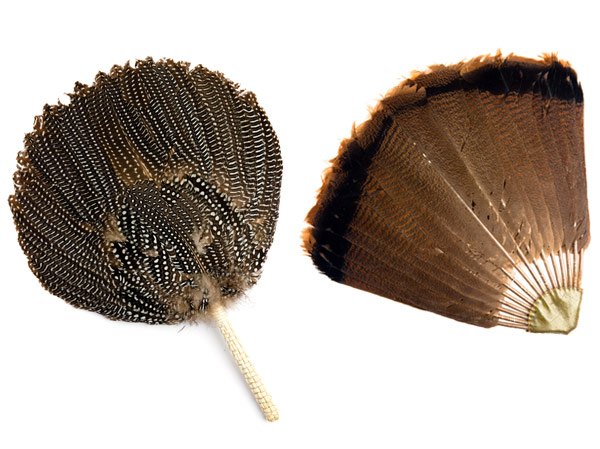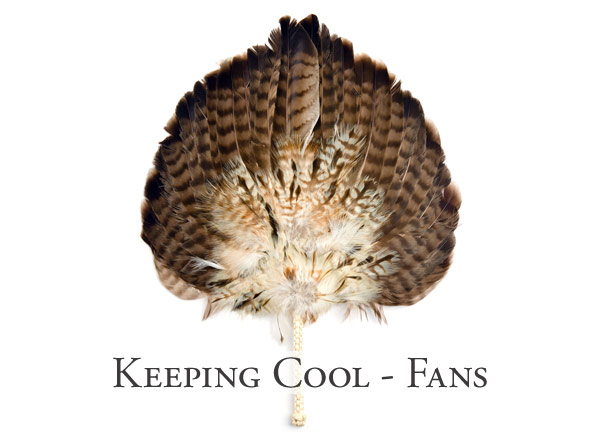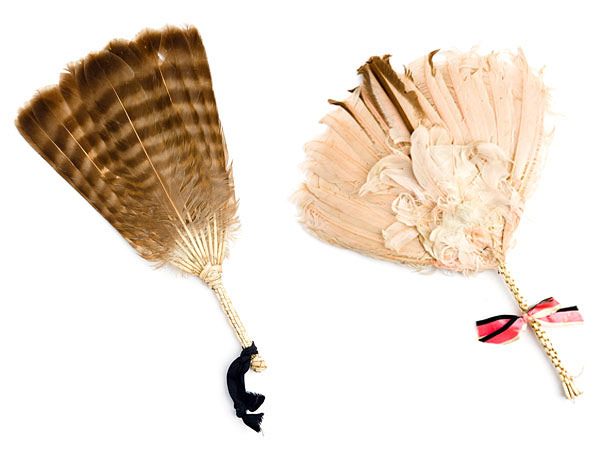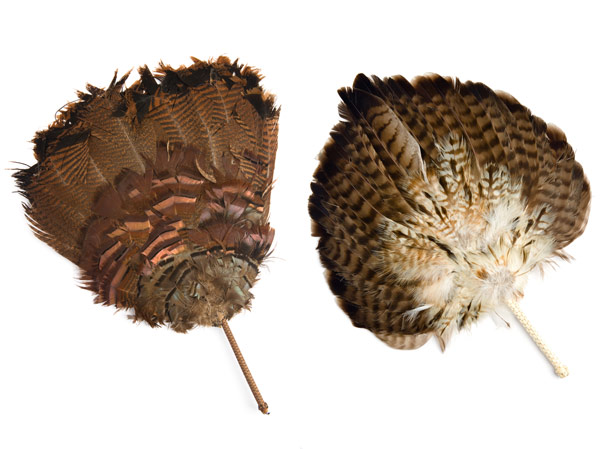Keeping Cool – Fans
PAST EXHIBIT
Keeping cool in the sweltering South Carolina Lowcountry has been a challenge from the days of the first European settlers. Dressed in their European finery, they surely felt the heat – and humidity, just as we do today. But fashion generally won out, and women coped as well as they could through the long, hot summer.
Yes, the 18th and 19th centuries were well before air-conditioned comfort, but one must remember that there was less pavement, less congestion and probably more shade. Houses were situated to catch the cooling breezes; the large porches, big open windows and high ceilings helped as did separate kitchen buildings – and someone else to do the cooking and heavy labor.
 (Left) The brown and white spotted guinea fowl feathers were also a popular choice. This lovely fan belonged to Annie Pierce Smyth Blake (1875-1957) of Charleston.
(Left) The brown and white spotted guinea fowl feathers were also a popular choice. This lovely fan belonged to Annie Pierce Smyth Blake (1875-1957) of Charleston.
(Right) Major Horace Hann Sams of Beaufort made this fan of 16 turkey feathers in the mid 19th century. The quills are sewn into a triangular “handle” of leather.
But it was still hot and sticky. Clothing of natural fibers wicked the moisture from the body, cooling as it evaporated. And anyone could use a clever ancient device – the hand fan. From a simple stiffened
palmetto frond to an elaborate carved and lithographed work of art, the fan could provide a personal, but effective, breath of air. And these hand fans were extremely popular throughout the 18th, 19th and into the 20th century – for cooling and for fashion. The Charleston Museum has an extensive collection of these lovely accessories, many used right here
by women long ago. While the imported ivory and mother-of-pearl fans are beautiful, some of my favorites are the more utilitarian fans made here of local materials. Ubiquitous in the Lowcountry were feather fans, using turkey and other plentiful birds. Often referred to as “church fans,” feather fans could be left around for anyone to use, providing a little respite from the relentless climate.
(Left) Tobias Scott, an African-American professional fan maker in Charleston (working at least from 1876-1888) wove the quills into a handle for these 12 feathers, in a technique similar to the Choctaw feather fans and other Native American fans.
(Right) The brown and white spotted guinea fowl feathers were also a popular choice. This lovely fan belonged to Annie Pierce Smyth Blake (1875-1957) of Charleston.
(Left)This magnificent turkey feather fan from John F. Maybank’s plantation in Green Pond was made by Charlotte Boykin Gammage. She used pine needles from her home in Camden for the handle.
(Right) The brown and white spotted guinea fowl feathers were also a popular choice. This lovely fan belonged to Annie Pierce Smyth Blake (1875-1957) of Charleston.
A quote from Our Women in the War – No. 17, “Eight Miles Under Fire,” by a Georgia woman, perhaps sums up the importance of these wonderful feather fans:
Preparing for a hurried flight from the family home at Resaca, Georgia, Captain Mitchell was helping his family leave before the battle began. His mother was frightened and overwhelmed. “With her Bible and a large turkey-tail feather fan, from which she was never known to be separated summer or winter, she stood ready to depart, praying and fanning herself…” as her daughters quickly packed valuables onto the wagon.
The family managed to ride eight miles under fire, crossing the Oostanaula River, ending up in Calhoun which was also besieged for the next two days. For the next two years they were homeless refugees, staying with kind friends, until they could return to their ruined home.




